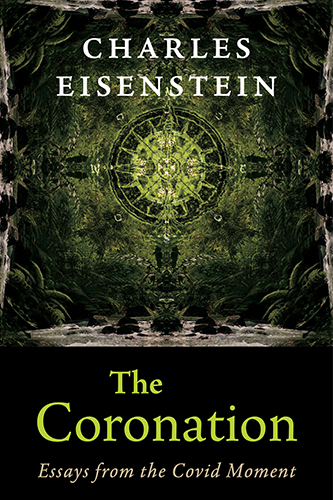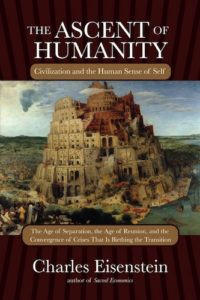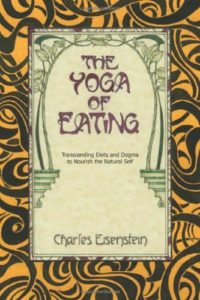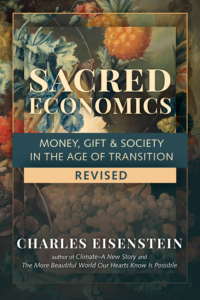Climate — A New Story
Chapters
Chapter 7: The Revolution is Love
The Concrete World
We can be peaceful in our fervor and patient in our urgency. We let in the grief, and compassion and clarity follow it in. We stand in awe of the intelligence that weaves it all together and orchestrates the mysterious causal pathways that link the rhinos to the prisons to the corals to the cancer wards. But that does not answer my friend’s trembling worry: What if he is right? What if the future just contains concrete with cows, pigs, chickens, and their shit?
In this book I have referenced the idea that human well-being and planetary health are inextricably connected, and that no such future is possible. I will now explore the opposite idea: that human ingenuity is unlimited, as is our capacity to replace ecosystem services with technological substitutes.
In other words, what if the version of the Story of Interbeing I’ve given you is wrong? What if we can, in fact, forever insulate ourselves from the effects of our actions? What if the techno-optimist position on the spectrum of climate change opinion is right—that climate change is just a technical hurdle in humanity’s race to its glorious destiny?
While it is fashionable to attribute the collapse of past civilizations to ecological degradation, these narratives are subject to critique. Consider for example the famous case of Easter Island, whose transition from a wildlife-rich, forested paradise to a treeless desert island devoid of any large fauna is used as a cautionary object-lesson in population overshoot and ecological destruction. Jared Diamond, who popularized this narrative in his book Collapse, chronicled the descent of a highly developed civilization of more than fifteen thousand people into poverty and cannibalism, following their hunting to extinction the island’s land and sea birds and cutting down the trees to fuel their obsession with building their famous stone monoliths.[1] The parallels to our own civilization are obvious.
This narrative has come into question recently by Terry Hunt and others, who argue that it was rats (which traveled to the island with the Polynesian colonizers) that were largely responsible for the deforestation, and that the human population never reached fifteen thousand but remained fairly constant until the arrival of Europeans.[2] In other words, ecological collapse was not followed by social collapse. To the contrary: despite ecological collapse, the society maintained its numbers and social cohesion on its desolated landscape. They spread broken volcanic rocks whose gradual breakdown fertilized vegetable gardens, they ate rats for protein, and they enjoyed enough abundance to continue building stone monoliths. Naturalist J. B. MacKinnon notes that population dropped and the culture unraveled only after first European contact brought lethal new diseases to the island.[3] At first contact, the locals were more interested in trading for hats than for food or other “necessities.”[4] This was not a desperate society.
History is often a projection screen for contemporary prejudices. In an era when we fear ecological collapse, it is natural that we would view history through that lens. Historical examples can also be used purposely to intensify the alarm that environmentalists hope will motivate change. I think, though, that the change we need must come from a different place than self-interested alarm.
For me, the implications of the revisionist Easter Island narrative are more chilling than the possibility of ecocide-driven collapse. It suggests that a concrete world of “cows, pigs, chickens, and their shit” might be possible after all. As MacKinnon puts it in his poignant and insightful book, The Once and Future World,
What the Easter Island stories represent are the two possible end points for our global culture if we continue on our current course toward an ever more simplified and degraded natural world. In the first telling, the fates of nature and humanity are entwined and both go down together in a social and ecological catastrophe. In the second telling, human and non-human life take different paths. The planet’s ecosystem is reduced to a ruin, yet its people endure, worshipping their gods and coveting status objects while surviving on some futuristic equivalent of the Easter Islanders’ rat meat and rock gardens.[5]
This passage evokes a nightmare world where the entire biosphere has been converted to a giant feedlot and industrial park, where we manage the planet like a machine with technological tweaks to its gross material components, where no species exists that has not been turned to human purposes. It is a world wholly toxic to life except within artificially maintained enclaves. It is a world of vat-grown meat, computerized hydroponic greenhouses instead of farms, algae pools for oxygen, carbon-sucking machines to regulate the atmosphere, desalinization plants, climate-controlled air-filtered bubble cities, and a planetary surface converted to one huge mine and garbage dump. In that world, human life becomes entirely dependent on technology, as we retreat from the ugliness we have wrought into an artificial or even a virtual environment. Can you say this isn’t already under way? This is not a world I would want to live in. No one would, yet for thousands of years, humanity in aggregate has proceeded choice by choice, step by step toward a Concrete World. I would like to dismiss it as impossible on ecological grounds, but what if it is possible? What if, instead of being compelled to reject it, we must consciously choose a different path?
Climate activists are fond of saying, “We are going to have to change now.” Maybe the significance of climate change is not “Change or perish,” but an invitation to reorient civilization toward beauty rather than quantity. Starkly confronting us with the results of our power, it asks, “What kind of world do you want to live in?”
Whether or not endless technological adaptation to an ever-more-degraded ecosystem is actually possible, the perception that it is possible indeed presents us with the necessity of making a conscious choice. If ecological degradation had the power to force us to choose a healing path, it would have happened already. Therefore, that choice to take the healing path will have to be made on some basis other than compulsion. It will not come through fear of personal or civilizational extinction.
I want to repeat: if ecological degradation had the power to force us to choose a healing path, it would have happened already.
Is the choice to heal ever really forced on us? Some people quit smoking on the first diagnosis of lung disease; others persist in smoking through their tracheostomy hole even as lung cancer wracks their body. What is happening when we reach that critical moment where we hit bottom, where the old life becomes intolerable? When do we say, “Enough. I’m out of here”? When do we finally quit that job, leave that relationship, take that journey, quit that addiction, release that grudge? Usually a course reversal toward wholeness is sparked by some kind of crisis, but it is not guaranteed by one. Each crisis, each tragedy, each new injury or loss is an invitation onto a different path. It is up to us to accept that invitation.
As the deterioration of the biosphere proceeds, we will surely face many crises, tragedies, and losses. If fear of further loss is not enough to change our course, what is? The dominant environmental narrative, especially when it comes to climate, is based on fear of consequences for humanity. What do we choose from when we don’t choose from that fear?
Most people will offer love as the antipode of fear. I’m wary of this formula, which veers close to replicating the familiar paradigm of good versus evil. Fear is not always a bad thing; sometimes it can heighten one’s wakefulness and focus, and catalyze action. That action might be in service of those we love; it needn’t be in service of self-preservation. We care about what we love, even when that caring in no rational way contributes to our measurable benefit. Sometimes we even sacrifice our lives for what we love. Love makes us care more passionately than self-interest can, and, as Dr. Seuss put it in The Lorax, “Unless we begin caring a whole awful lot, nothing is going to get better. It’s not.” Nature might not save us from ourselves.
So the care we need to live in a more beautiful world comes from love. But how does love awaken? One way is through loss, grief, and the realization of death. When a friend or family member falls ill or has a near brush with death, or enters into the dying process, the reality of their preciousness overcomes my holding patterns and opens me to deeper care. Unfortunately, these holding patterns have a powerful ally in modern society’s denial of death—its fetish for youth, preservation, and growth. Denial of death holds life at bay too. It usurps love and enthrones the pretender we call ego. Modern civilization upholds an equivalent pretense in its ideology of human exceptionalism: that human beings and human society can be exempt from limits. The untrammeled growth of the separate self, whether the personal self or the collective human self, is inimical to love. Therefore, death, loss, and grief are love’s allies.
Another partner of love, in its awakening and its expression, is beauty. We fall in love with what is beautiful, and we see beauty in what we love. Let us consider beauty then to replace utilitarian benefit as the motivation and aim of humanity’s relation to the world. Whether or not a world of rats and concrete is survivable, it is definitely not as beautiful as the “once and future world” that MacKinnon describes.[6] Explorers and naturalists of previous centuries give staggering testimony to the incredible natural wealth of North America and other places before colonization. Here are some images from another book, Steve Nicholls’s Paradise Found:
Atlantic salmon runs so abundant no one is able to sleep for their noise. Islands “as full of birds as a meadow is full of grass.” Whales so numerous they were a hazard to shipping, their spouts filling the entire sea with foam. Oysters more than a foot wide. An island covered by so many egrets that the bushes appeared pure white. Swans so plentiful the shores appear to be dressed in white drapery. Colonies of Eskimo curlews so thick it looked like the land was smoking. White pines two hundred feet high. Spruce trees twenty feet in circumference. Black oaks thirty feet in girth. Hollowed-out sycamores able to shelter thirty men in a storm. Cod weighing two hundred pounds (today they weigh perhaps ten). Cod fisheries where “the number of the cod seems equal that of the grains of sand.” A man who reported “more than six hundred fish could be taken with a single cast of the net, and one fish was so big that twelve colonists could dine on it and still have some left.”
I used the word “incredible” advisedly when I introduced these images. Incredible means something like “impossible to believe”; indeed, incredulity is a common response when we are confronted with evidence that things were once vastly different than they are now. MacKinnon illustrates this phenomenon, known in psychology as “change blindness,” with an anecdote about fish photographs from the Florida Keys. Old photographs from the 1940s show delighted fishermen displaying their prize catches—marlins as long as a man is tall. When present-day fishermen see those pictures, they flat-out refuse to believe they are authentic.
Human beings tend to be blind to gradual changes in their environment, assuming that the way things are right now is how they always have been and always will be. We do not miss the former beauty of the world, he would say, because we have never known it.
I am not so sure that we don’t miss it. I think we do miss it, but we don’t know what it is we are missing. We feel a void, a sense of poverty, a hunger for something unidentifiable. Transferred onto money or consumer items, that hunger drives continued cycles of destruction. Transferred onto drugs, gambling, alcohol, it drives the unsolvable social problem of addiction. Perhaps the degradation of nature is not without its consequences after all.
Even a taste of this lost abundance nourishes me deeply and points to a kind of wealth that may one day be restored. Once I went swimming on the north coast of Scotland, and a seal swam over to check me out, popping its head out of the water in an aspect of comical curiosity. That image still enriches my brain. On my brother’s farm in June I spend long minutes gazing at the lightning bugs, sparkling like Christmas decorations in numbers I haven’t seen since my childhood. They make me feel at home in the world.
When I lived in Harrisburg I visited a greenbelt near my house every day. Although the land was enclosed by the city, and the stream tainted with leaking sewage, and the woods infested with ticks and poison ivy and drug deals at night, still I found special spots where I would go watch the play of the minnows, and stand where the birds found refuge. Without that nourishment I doubt I’d be writing this today.
Despite all that has been lost in our progress toward a concrete world, much beauty remains. The earth is still alive. Now is the time to choose life. It is not too late.
Most people would acknowledge a feeling of loss at the thought of a world without elephants, rhinos, or whales. But, the cynic might say, we’ll get used to it and not know that anything is missing, just as you probably are not mourning the loss of the Pyrenean ibex or the hundreds of nameless species going extinct every year. However, in the Story of Interbeing, where self is relationship, each extinction impoverishes the web of relationships on Earth that includes ourselves; it shrinks us and simplifies us. Extinctions are the end result of an ideology that makes other beings into less than full beings and excludes them from the circle of self. First, they are cast out of full existence via our belief system; in the end, the casting out takes irrevocable physical form. First, the mythology of separation isolates us from our companions, who are really part of ourselves; then those companions perish forever.
This impoverishment goes beyond outright extinction. Many species, while not entirely extinct, persist as remnant populations on tiny fragments of their former range. Thus they recede from our lived experience. Moreover, modern people live almost entirely in a realm of products, media, and the indoors, estranging them from the life forms remaining in their ambit. I cannot identify the name and likeness of more than ten bird species from their songs. Can you? I hope you can, but I think most in my culture cannot. This degree of alienation is normal now.
One consequence of this is an ever-growing loneliness, an ache that nothing in the indoor world, manufactured world, or digital world can assuage. We miss the complement of our relationships in all their diversity. Standardized, digitized, or abstract relationships do not nourish full beingness. Surrounded by standardized commodities, visiting public spaces filled with strangers, interacting increasingly through the internet, and distanced from intimate relationship with nature in a world of climate-controlled houses, packaged food, and machine-mediated labor, we are poor in our very existence. Do we still survive? Yes. From the perspective of the Story of Separation, we continue to exist. But it is a partial, anemic existence. For the interconnected self, existence is not a binary yes/no. Existence admits to degrees that depend on wealth of relationship.
I think that “Could we survive in a ruined world of synthetic food and concrete algae pools?” is the wrong question. Better questions might be “What will we become?” “Who do we want to be?” and “What kind of world shall we choose?”
The climate crisis and general ecological crisis may not be about the survival of our species at all. It may be an initiation into a new orientation altogether. The question then becomes not whether we can survive, but how we want to live. It becomes no longer how to achieve sustainability, but what we want to sustain.
End Notes
[1] Diamond (2005).
[2] Hunt (2006).
[3] MacKinnon (2013), 199.
[4] Ibid., 198.
[5] Ibid.
[6] The reader might object that aesthetic sensibilities vary; that some people find glass skyscrapers more beautiful than forests and waterfalls. I myself find certain skyscrapers beautiful (though rarely any built after 1950). One might ask: is it really beauty that draws people to environments of steel, glass, and chrome, or is it security? And do they know what they are missing?






